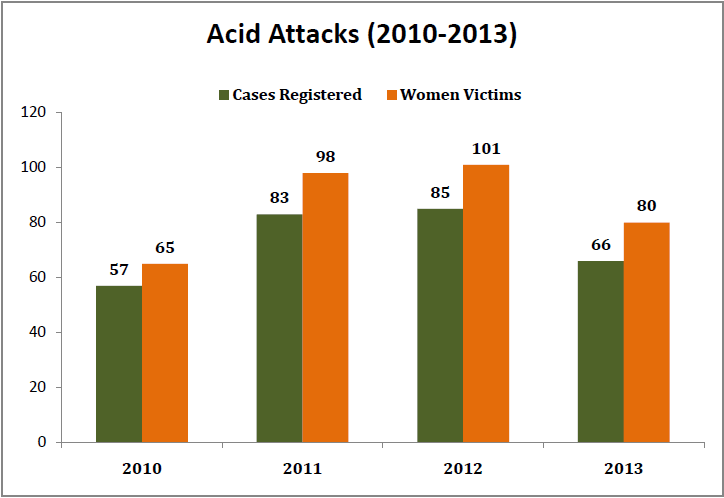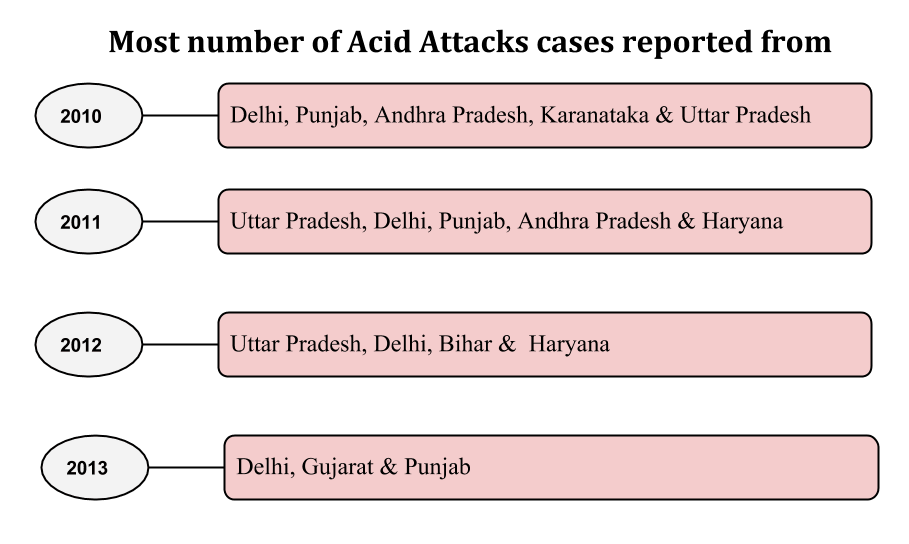[orc]According to the data available with the Government, a total of 291 cases of acid attacks were reported in the country from 2010 to 2013. A total of 344 Women were vicitms of these attacks. States like Delhi, Uttar Pradesh, Punjab, Haryana, Andhra Pradesh have reported the highest number of cases. The Union Home Ministry has issued an advisory in August 2013 with details of measures to be taken by States/UTs to prevent acid attacks.
Acid attacks are gruesome and most often, it is women who are victims of these attacks. It is not just the physical trauma, but the mental agony one goes through after such attacks that warrants a serious look at these crimes. The Supreme Court while hearing the “Laxmi Minor vs.Union of India (WP 129 of 200)” has directed the Government of India to come up with guidelines following which the Union Home Ministry issued detailed guidelines outlining the measures to be taken to prevent acid attacks on people and for treatment.
Acid Attacks – The Numbers
It was not until recently that the National Crime Records Bureau(NCRB) started collecting the data on acid attacks and as such the only information available is from 2010 and going forward. There is clear indication from this data that most of the victims are the women. The number of acid attacks cases increased by close to 50% in 2011 and it remained more or less constant in 2012. Though it looks like the number of cases have come down in 2013, it is not a true reflection of the situation since data of more than 10 states that reported cases in the previous years is not available with the government. The victims are all Women with a total of 344 victims in these 4 years.
Most number of cases in 2010 was reported from Delhi, Punjab, Andhra Pradesh, Karnataka & Uttar Pradesh in that order. In 2011, it was Uttar Pradesh followed by Delhi. In 2012, Uttar Pradesh topped the charts again followed by Bihar & Delhi. In 2013 Delhi topped the charts followed by Gujarat & Punjab out of those states for which the data is available. What is also evident from the data, that it’s not a north or south phenomenon. The gruesome acid attack incidents were reported both from the north and south India.
For the years 2010, 2011 & 2012, charge sheet was filed in about 85% of the cases. For 2013, Charge sheet was filed only in 62% of the cases.
The Guidelines
Thanks to the efforts of an acid attack survivor, Laxmi, whose PIL with the Supreme Court paved way for “The Poisons Possession and Sale Rules, 2013″. While this may not necessarily eliminate the problem of the acid attacks, it does have a potential, if implemented strictly, to at least reduce the number of such acid attacks.
The Union Home Ministry sent an advisory in August 2013 on measures to be taken to prevent acid attack on people and free treatment and rehabilitation. The advisory also directed the States and Union Territories, where rules to regulate sale of acid and other corrosive substances are not operational, the concerned States/ Administrators of the Union Territories shall ensure the compliance of the following directions with immediate effect. Some of the important measures suggested are
- Over the counter, sale of acid is completely prohibited unless the seller maintains a log/register recording the sale of acid which will contain the details of the person(s) to whom acid(s) is/are sold and the quantity sold. The log/register shall contain the address of the person to whom it is sold.
- All sellers shall sell acid only after the buyer has shown:
- A photo ID issued by the Government which also has the address of the person:
- Specifies the reason/purpose for procuring acid.
- All stocks of acid must be declared by the seller with the concerned Sub-Divisional Magistrate (SDM) within 15 days.
- No acid shall be sold to any person who is below 18 years of age.
- In case of undeclared stock of acid, it will be open to the concerned SDM to confiscate the stock and suitably impose fine on such seller up to Rs. 50,000/-
- The concerned SDM may impose fine up to Rs. 50,000/- on any person who commits breach of any of the above directions.
The educational institutions, research laboratories, hospitals, Government Departments and the departments of Public Sector Undertakings, who are required to keep and store acid, shall follow the following guidelines:
- A register of usage of acid shall be maintained and the same shall be filed with the concerned SDM.
- A person shall be made accountable for possession and safe keeping of acid in their premises.
- The acid shall be stored under the supervision of this person and there shall be compulsory checking of the students / personnel leaving the laboratories/place of storage where acid is used.
Some of the acids that are banned or regulated include Acetic acid (beyond 25% concentration by weight), Sulphuric acid (beyond 5% concentration by weight), Hydrochloric acid (HCI) (beyond 5% concentration by weight), Phosphoric acid etc.
Compensation
While there can be no compensation for the trauma suffered by the acid attack survivor ever, the rule does have a provision to be compensated so that it at least takes care of the after care and rehabilitation costs. The Supreme Court has also directed that the acid attack victims shall be paid compensation of at least Rs. 3 lakh by the concerned State Government/Union Territory as the after care and rehabilitation cost.
Citizens can confront the SDM within their respective districts and hold them accountable for the implementation of these measures in letter & spirit.
Only time will tell if these measures would be successful in reducing the number of acid attacks.
Source: Ministry of Home Affairs, Unstarred Question No 3800, answered on 16th December, 2014 in the Lok Sabha.
Featured Image Source: Flickr | Narayan Nath/FCO/Department for International Development





1 Comment
Pingback: Acid doesn’t end life … – BE INSPIRE